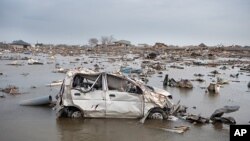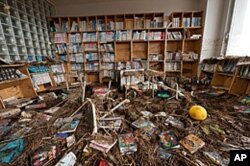The death count has passed 14,000 from the earthquake and tsunami that struck northern Japan on March 11. Nearly as many people remain missing. As recovery efforts continue, a Los Angeles photographer who has documented Japan in books and articles returned to see how life has changed in the stricken region.
Mark Edward Harris has traveled to Japan many times to photograph its sights, including its famous hot springs. He paid a visit to the scenic Tohoku area of northeast Japan last year, four months before the area experienced a magnitude 9 earthquake and devastating tsunami.
Harris wanted to go back, saying that he felt an obligation to tell the people’s story, so he contacted a friend, Yoshi Ohkuma, who works for the Japan Travel Bureau. Ohkuma had guided him on the previous trip to northern Japan.
"And at first he said, 'Oh don’t come. Now is not a good time, with the devastation and all.' And then he reflected upon it, and I got an email soon after that saying, 'This is exactly the right time, and I want to be part of it. And I won’t do it as official work, because it’s not tourism, but it’s important to tell the story,'" he said.
The two men drove to the stricken area in Miyagi and Iwate prefectures. One month after the disaster, the search for survivors had ended. The rescue teams were gone, replaced by crews with cadaver-sniffing dogs who continue to search for bodies in the rubble.
Harris says he saw stark contrasts.
"You go up a few feet in elevation, and all of a sudden, everything looks fine. But then you go over a hill and you descend again into the next town, and that’s been obliterated. And the distance of just driving, and we drove many, many miles down the coast, of this continuous theme of devastation, driving up, everything looks fine, and then right back down into another town," he said.
He says the scenes in the stricken towns were striking. In Otsuchi, for example, a cruise ship sits atop a building, as local people try to return to normal life. "And then in a place called Kamaichi, a huge ship breached the sea wall, but then you have people walking in the foreground trying to go about their daily business best they can. Yet you have this very surreal scene behind them of this ship hanging over," he said.
He says that children’s stuffed animals were everywhere, and there was other evidence of life that for many had suddenly ended.
"There was a pachinko parlor/casino [where] there was money, these coins, still in the trays where people had been playing and all of a sudden, had to evacuate, and the place just came apart," he said.
He says people were anxious to tell their stories. In the suburbs outside Sendai, a survivor named Chie took them to a kindergarten that served as a community refuge in what should have been a safe zone.
"The people that went to this one building on the second floor were fine, but when the tsunami came in much further than expected ..- this really was inland ..- it obliterated the people and building on the first floor. And so she took us over to that. She wanted to share that. And it was very sad to go into this kindergarten where there was a sign hanging saying, congratulations on graduating, and it was just a scene of carnage there," he said.
Harris says that both he and his friend from the travel bureau were moved by the devastation, unlike any that Japan has experienced since World War II.
"It was such a surreal scene, and Yoshi had commented that this is what it must have been like to walk through Hiroshima after August 6, 1945," he said.
Harris says it was also clear that the space of less than a meter could make the difference between life and death. Water swept through one building up to the fourth floor. Its fifth floor was untouched.
The photographer wrote in an earlier book on Japanese hot springs that the country’s way of life and scenic natural beauty are made possible by its location on the so-called Ring of Fire, the Pacific region known for mountains and volcanoes, earthquakes and tsunamis. He says the Japanese have rebounded from past disasters, and despite the devastation, those he spoke with say it will rebound again this time.











